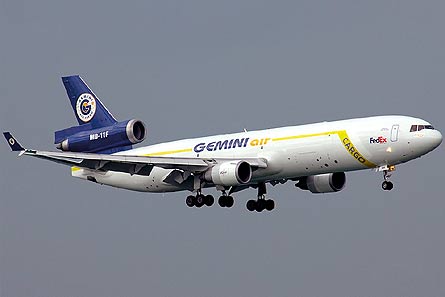By David Kaminski-Morrow in London
Gemini Air Cargo MD-11F descended 1,000ft too far after 'distracted' pilots failed to set altimeter to local pressure
Investigators have concluded that the failure of a Gemini Air Cargo Boeing MD-11F's crew to set the altimeter correctly led to the trijet making an unusually low night-time approach to Nottingham East Midlands airport last year.
The aircraft descended to less than 720ft (330m) in darkness while still 7nm (13km) from the airport as it arrived from Cologne/Bonn airport on 3 December.
Its crew were preparing for an instrument landing system approach to runway 27 when air traffic control cleared the aircraft to descend to 2,000ft on an altimeter pressure setting of 974mb.
But the UK Air Accidents Investigation Branch (AAIB) says that, at the time, the crew was "distracted" because they were closely monitoring the heading to ensure that the aircraft was on course to intercept the localiser.
|
|---|
| The Gemini MD-11 descended to 700ft when it was 7nm from touchdown at Nottingham East Midlands airport |
Despite acknowledging the descent clearance and the pressure setting to air traffic controllers, the crew did not enter this setting into any of the trijet's three altimeters.
The altimeters were left on the standard setting of 1013mb, meaning that they would have incorrectly indicated the aircraft to be 1,100ft above its true altitude.
Radar data shows that the aircraft descended to 718ft above ground level, 7nm from touchdown, and maintained this height until it intercepted the glideslope at 2nm. During a typical landing an aircraft 7nm distant is at 2,200ft.
When the tower controller took responsibility for the aircraft just before it landed he queried the crew about the altimeter setting because the MD-11 appeared to be much lower than it should. At this point the crew corrected the settings and the aircraft landed safety.
"Close monitoring and effective action by the tower controller enabled the true situation to be identified and resolved," says the AAIB, adding: "At night and in sight of the [approach path indicator] lights it would have been difficult for any of the crew visually to appreciate that they were much lower than required by the procedure.
"Furthermore the two main and single standby altimeters would have indicated the same altitude and raised no concerns. The main indication of a discrepancy available to the crew would have been the radar altimeter and it was therefore apparent that the instrument had not been part of any crew member's scan."
The AAIB says the aircraft maintained level flight, albeit at low altitude, and there was "no possibility" of an accident. But it stresses the importance of ensuring that checklists are fully completed and adds that the radar altimeter should be included in a crew's instrument scan.
Source: Flight International
























